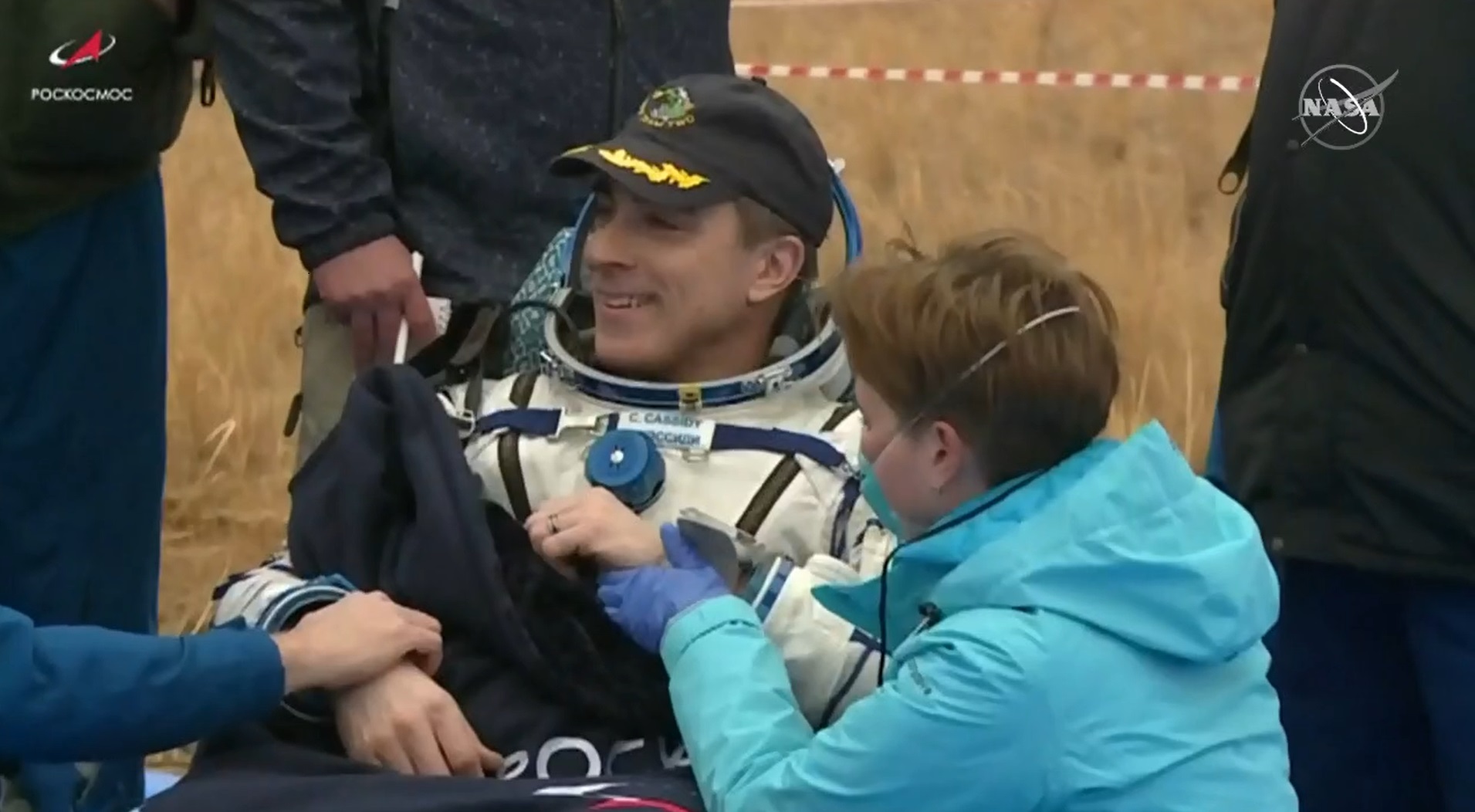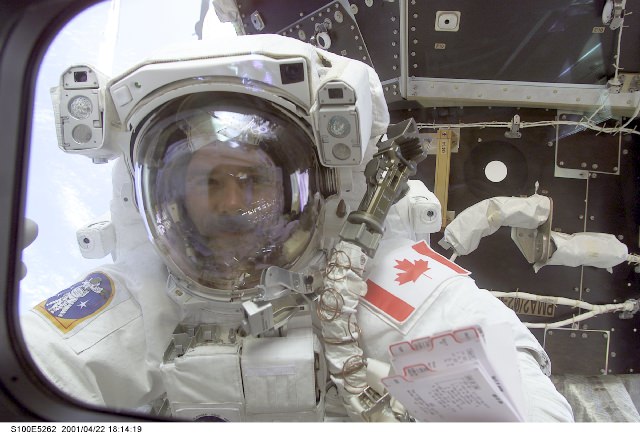On the evening of Wednesday, Oct. 21st, the crew of Expedition 63 finally returned to Earth after spending 196 days in space. It all began when NASA astronaut Chris Cassidy (commander) and Russian cosmonauts Ivan Vagner and Anatoly Ivanishin (both flight engineers) departed the International Space Station (ISS) aboard their Soyuz spacecraft at 07:32 PM EDT (04:32 PM PDT) and landed in Kazakhstan by 10:54 PM EDT (07:54 PM PDT).
Continue reading “ISS Crew Return Safely to Earth”Astronaut Drops a Mirror During a Spacewalk. Now There’s Another Piece of Space Junk
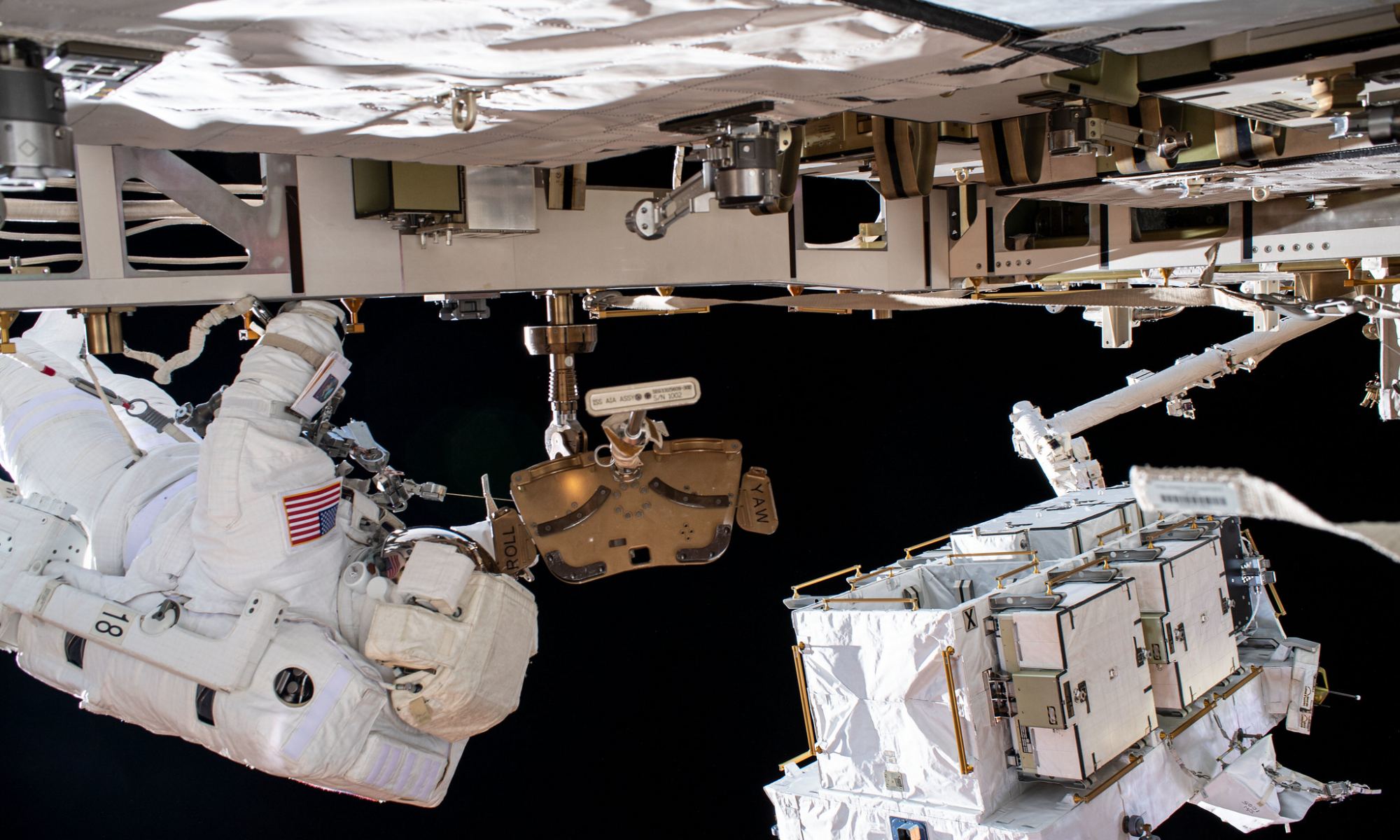
Oops.
Dropping a mirror on Earth is only minor cause for concern, perhaps about the potential of some upcoming bad luck. Dropping a mirror while on a spacewalk means creating a potentially dangerous new piece of space junk, all while thousands of people watch it happen, streaming live.
Continue reading “Astronaut Drops a Mirror During a Spacewalk. Now There’s Another Piece of Space Junk”Spacesuit Leak: Why It Took NASA 23 Minutes To Send Astronaut To Safety
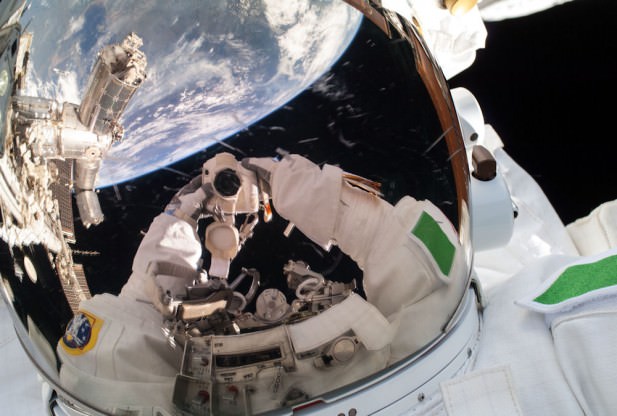
It took NASA almost the same amount of time as a sitcom episode to send Luca Parmitano back to the airlock when the Italian astronaut experienced a leak in his spacesuit last summer, a new report reveals.
The 23-minute gap of time between when Parmitano first sent a report of water in his helmet, to when NASA told him to go back to safety, exposed the astronaut “to an increased level of risk”, the report said. While Parmitano emerged from the incident safely, in his last minutes inside the spacesuit the water was covering his eyes, getting close to his nose and mouth, and affecting the communications equipment.
“There wasn’t an issue of anything being hidden or surprised. It was a lack of understanding about the severity of the event. It was believed a drink bag caused the leak,” said Chris Hansen, the chair of the mishap investigation board, in a press conference today (Feb. 26).
This misunderstanding, added Hansen (who is also the chief engineer of the International Space Station Program) also led to a problem when a leak occurred in the same suit just the week before.
Parmitano’s water leak occurred July 16 when he and Chris Cassidy were preparing a part of the International Space Station for a new Russian module. Until today, however, few knew about the existence of a second leak in the same spacesuit that happened on July 9, when Cassidy and Parmitano were doing another spacewalk together.
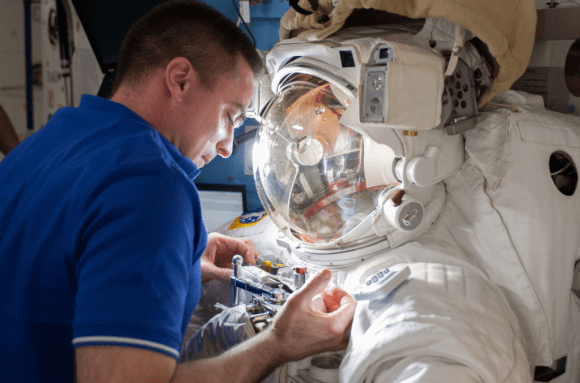
After the conclusion of “EVA 22” on July 9, as NASA called the extra-vehicular activity, Parmitano took off his helmet and crew members discovered between 0.5 and 1 liters (0.13 to 0.26 gallons) of water inside. Cassidy told the ground that he could not see any water during the spacewalk or repressurization, leading NASA to conclude the water got into the helmet in the airlock.
“Also,” the report noted, “[Parmitano] was looking down and leaning forward and likely had pressed on the drink bag with his chest and could have pinched the bite valve open with his chin, releasing water into his helmet. The ground team accepted the crew’s drink bag leak assessment and the presence of excessive water in the helmet was not investigated further … The ground team instructed the crew to use a new drink bag for the upcoming EVA 23, which they did.”
Hanson emphasized that the crew did not make the final call, and that the ground team did ask some questions about what was going on, but the assumption that a drink bag caused the water was also a key feature of the July 16 spacewalk when the leak began to show itself in earnest.
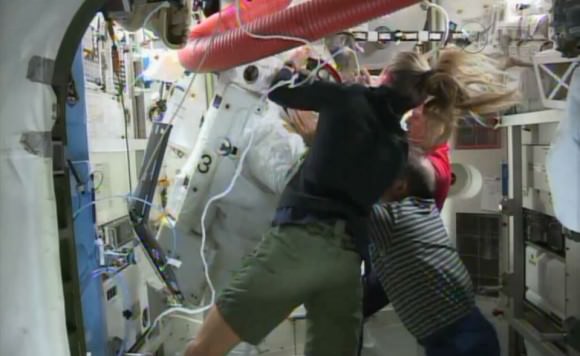
Also, NASA did not well understand the physics of how water worked inside of the suit, assuming there was no way for liquid to make it past a fan pump separator into the helmet unless the fan itself shut off. If that scenario arose, NASA would have kicked into a 30-minute return-to-airlock procedure, and that was in the back of controllers’ minds as they were working through the fault tree during the July 16 spacewalk, officials said in the phone call today.
In the short term, the authors of the report have several “Level 1” or priority recommendations that they should be implemented before normal spacewalks resume. NASA said it’s planning to work through these and “Level 2” recommendations in time for June, with the aim of getting spacewalks going again in July or August.
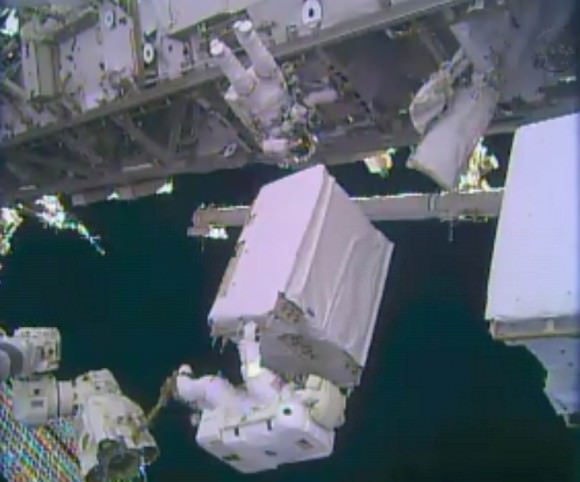
Emergency spacewalks can still go forward, as the agency has new safety measures in place (including snorkels). This happened in December as the astronauts replaced a faulty ammonia pump.
The agency has no pressing spacewalk tasks at this time. The broken pump, sitting in temporary stowage outside the station, was initially safed to stay there until summer, but further analysis shows that it could sit there for several months more.
You can read the entire 222-page report here. We’ll pull out more highlights tomorrow after we have some time to look over it in more detail, too. The exact cause of the leak is still under investigation.
What Caused The Spacesuit Leak? Astronauts Are Working To Hunt That Down
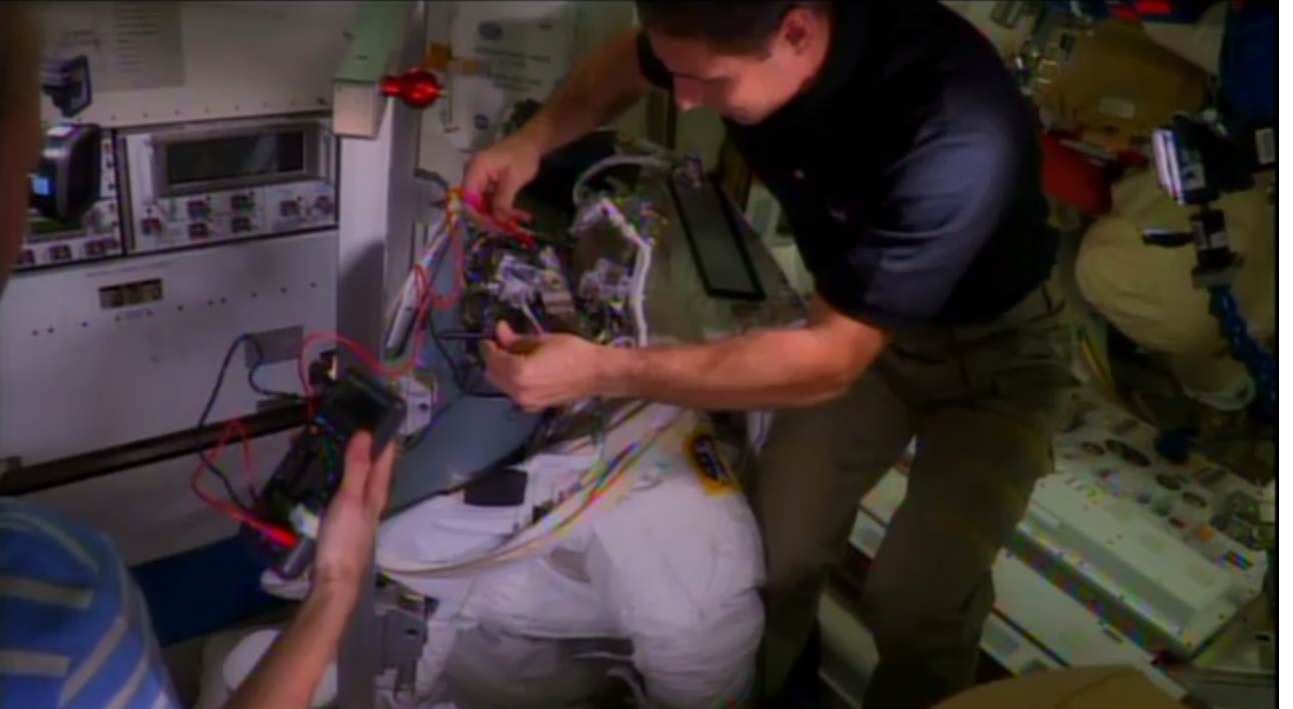
Here’s the latest attempt to hunt down the water leak that aborted Luca Parmitano’s spacewalk in July: two astronauts aboard the International Space Station removed and replaced a fan pump and water separator inside the spacesuit earlier this week.
All spacewalks with NASA suits are on hold while the agency investigates the leak, and they have been trying mightily. In late July, then on-station NASA astronaut Chris Cassidy demonstrated how the pool of water spread within the helmet (as you can see in these YouTube videos).
This week, on-orbit NASA astronauts Mike Hopkins and Karen Nyberg delved further. While the astronauts are trained before their missions on some suit repairs, this particular type was not something that was covered before they left Earth. After Mission Control walked them through what to do, the astronauts proceeded cautiously as they did the work, NASA said.
“Our engineering teams have identified several different components of the suit, designing a big fault tree, and this is just one of the components that we think could have contributed to the leak in the suit,” said Alex Kanelakos, an extra-vehicular activity flight controller and astronaut instructor, in a new YouTube video.
“Specifically, the water separator is what we’re concentrating our efforts on today.”
As Kanelakos explained, a motor inside the suit drives the fan pump and water separator. The fan circulates oxygen, and the pump pumps the coolant fluid. The water separator, meanwhile, takes out moisture (water) from the ventilation loop and gas that could be trapped inside the water coolant loop. The dried-out air is then returned to the crew member for breathing, and the cycle continues.

In September, Cassidy told Universe Today that the spacesuit is expected to come back to Earth during a future SpaceX Dragon cargo flight. That type of spacecraft is (unusually among space trucks) designed to survive re-entry in the atmosphere, allowing engineers on the ground to examine the spacesuit after it comes back.
Cassidy added that the situation was serious, and he supported NASA’s decision to end the spacewalk (which he was also participating in.) He didn’t think, however, that Parmitano was in immediate danger of drowning. For his part, Parmitano wrote a blog post on the European Space Agency website after his spacewalk, saying that space is an “inhospitable” arena.
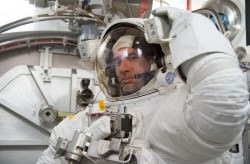
As any astronaut is trained to do, Parmitano did consider other contingencies while the leak was happening, he wrote:
“The only idea I can think of is to open the safety valve by my left ear: if I create controlled depressurisation, I should manage to let out some of the water, at least until it freezes through sublimation, which would stop the flow. But making a ‘hole’ in my spacesuit really would be a last resort,” he wrote.
That fix, however, was not implemented as Parmitano and Cassidy made their way back to the station in time for their crewmates to repressurize the hatch and bring their Italian crewmate safely inside.
Besides investigating the spacesuit, NASA has an ongoing parallel investigation to look at “lessons learned” from the mishap and ways of implementing procedures to stop such an incident from happening again.
Chris Hadfield Regretted Not Being Able To Make One Last Spacewalk
Chris Hadfield loved spacewalking. That was clear in a past interview he did for Universe Today:
It is like coming around a corner and seeing the most magnificent sunset of your life, from one horizon to the other where it looks like the whole sky is on fire and there are all those colors, and the sun’s rays look like some great painting up over your head. You just want to open your eyes wide and try to look around at the image, and just try and soak it up. It’s like that all the time. Or maybe the most beautiful music just filling your soul. Or seeing an absolutely gorgeous person where you can’t just help but stare. It’s like that all the time.
Late in Hadfield’s final mission to space this May, when the Canadian Space Agency (CSA) astronaut was commanding the International Space Station Expedition 35 crew, an ammonia leak happened and NASA had to scramble a plan for a spacewalk, or extravehicular activity (EVA), to fix it. (The fix succeeded.) When Hadfield was apprised of the plan, he says in an excerpt from his forthcoming book, he was disappointed:
I wasn’t going out. I had a moment where I allowed myself to experience the full force of my disappointment. This would have been the heroic climax of my stint as commander: helping to save the ISS by doing an emergency spacewalk. I’d never have another chance to do an EVA—I’d already informed the CSA that I planned to retire shortly after returning to Earth.
But Chris [Cassidy] and Tom [Marshburn] had both done three previous EVAs, two of them together, on the same part of the station where ammonia was now leaking. They were the obvious people for the job. All this went through my head and heart for a minute or two, then I made a resolution: I was not going to hint that I’d had this pang of envy, or say, even once, that I wished I was doing the EVA. The right call had been made, and I needed to accept it and move on so that we could all focus on the main thing—the only thing, really: working the problem.
An Astronaut’s Guide to Live On Earth isn’t out until Nov. 3, but Maclean’s magazine has a lengthy excerpt that not only talks about the spacewalk, but some behind-the-scenes discussion on Hadfield’s awe-inspiring version of David Bowie’s “Space Oddity” recorded on the International Space Station.
‘I Didn’t Think He Would Drown’: Spacewalking Crewmember on Spacesuit Leak
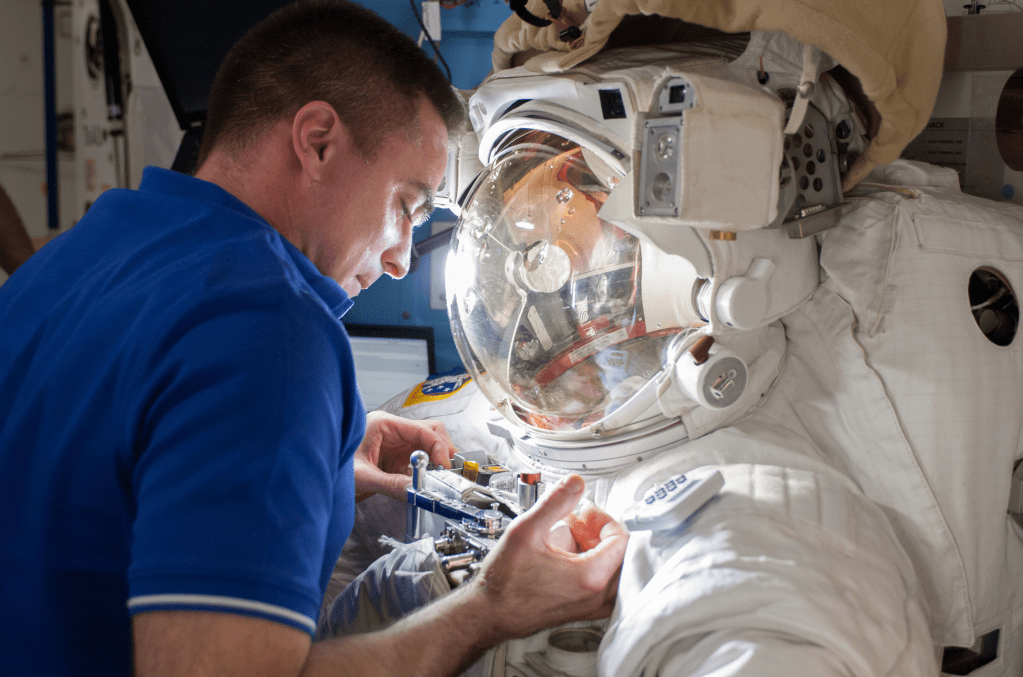
Safely back on Earth on Sept. 10, astronaut Chris Cassidy happily chatters about his daily trips to the gym — “I feel real solid with my walking”, he says — and cracks one-liners during one of a series of media interviews on Thursday.
“It was such a treat being up there with [Chris] Hadfield, and I think I need to get credit for filming some of those videos,” joked Cassidy in a phone interview from Houston with Universe Today. His favorite video with Canada’s Expedition 35 commander? A remake of David Bowie’s Space Oddity that got props from Bowie himself.
Cassidy’s half-year voyage in space was full of these light moments, such as his decision to shave his head in homage to his bald crewmate, Luca Parmitano, who arrived on the International Space Station as a part of Expedition 36 on May 29. Weeks later, however, the men’s mood turned serious during a July 16 spacewalk; Parmitano reported water pooling at the back of his head.
“I was watching out when we were face to face outside,” Cassidy said. “Once it got onto his eyebrow hair area, it whipped across the top of his forehead and then sort of slid around his eyeballs. It migrates from hair to hair, and the little wispy hairs around your eyes, kind of, and then it travelled towards his eyelids and eyelashes. That was the scary part.”
Cassidy is a former Navy SEAL who passed, first try, the grueling “hell week” all recruits go through. In 5.5 days, SEAL trainees get just four hours of rack time while having to move for up to 200 miles. A veteran of shuttle mission STS-127, Cassidy also accumulated more than 18 hours of spacewalking experience across three excursions. All of his knowledge was brought to bear as he watched the water travelling across Parmitano’s head.
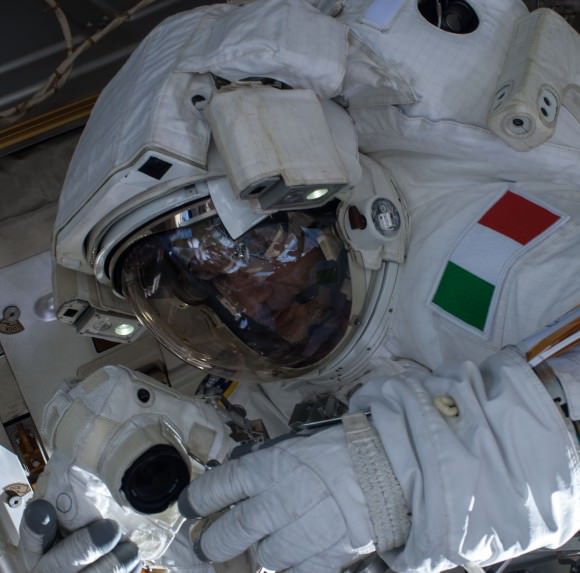
“From my experience in the military, I know bad things don’t get better fast, but they get worse fast. I wanted to get as quickly to the airlock as we could,” Cassidy said. NASA prudently ended the spacewalk and told Parmitano to head back to the hatch. Cassidy quickly did a cleanup at the work site and followed Parmitano.
“When we left each other at the work site and we had to go our separate ways back, at first I wasn’t too concerned,” Cassidy said. “And then when we left each other, the sun set. It was dark. His comm was going in and out and I could tell from his voice he was getting less and less comfortable … He didn’t have a whole lot of EVA experience, and it was nighttime, which is significant. It was pitch dark. You just have to know your way back, and he couldn’t see that well.”
Back in the hatch, Cassidy and Parmitano communicated through hand squeezes as the water was soaking Parmitano’s communications system. Cassidy carefully watched Parmitano’s mouth to see if the water was getting near there.
“I didn’t think he would drown, to be honest … but if it got close to his mouth I was going to immediately open the valve that equalizes pressure [inside the hatch.]” Cassidy added that usually, NASA goes slow during repressurization for ear safety and some technical reasons, but in this case he was prepared to flood the compartment if necessary. But it wasn’t. The rest of the crew then opened the hatch and got Parmitano out of his spacesuit as quickly as they could.

“Just from a human interest point of view, it was a lot of water,” Cassidy said. “When you try to describe an amount of water it’s difficult to put it in terms that people get it. But it was definitely more than a softball or two softballs of water inside the helmet.”
You can read Parmitano’s blogged account of the spacewalk here. The astronaut is currently unavailable for interviews while he is in orbit, the European Space Agency told Universe Today. NASA is still investigating the cause — the agency, in fact, also has a parallel investigation to look at spacewalk safety procedures in general. Cassidy attempted to change a filter and do other repairs in orbit, but the leak still happened, as these videos show. More detailed analysis will happen when the spacesuit goes back to Earth on a future SpaceX Dragon cargo flight, Cassidy said.
Cassidy also performed an emergency spacewalk in May when a coolant leak was discovered on the station itself as Hadfield’s Expedition 35 crew was set to return home. In just days — a typical spacewalk takes at least months to plan — NASA swiftly implemented a successful fix. Cassidy said his work was the easiest bit of all. “All I had to do was go out there and change the pump,” he said.
Despite the mishaps, however, science productivity on the station has reached a high when compared to maintenance activities. Expedition 35 reportedly had the most productive science mission to date, and Cassidy said Expedition 36 will likely show similar results. “We had a real nice successful six month stretch there where things were just working, and that allowed us to do a lot of science,” Cassidy said. One experiment involved playing with rovers.
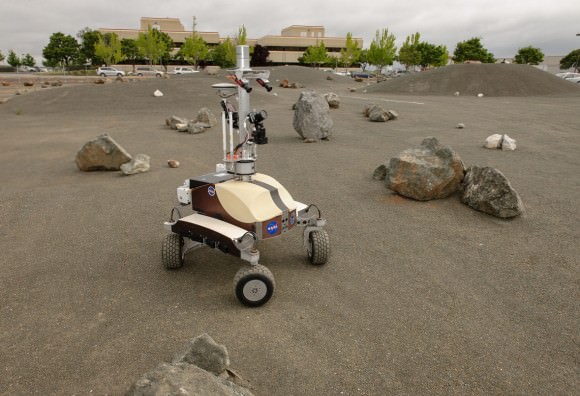
Credit: NASA/Dominic Hart
Cassidy, Parmitano and Karen Nyberg each took turns operating the K10 rover prototype, a NASA Ames Research Center project. The goal is to simulate how astronauts could control a rover on an asteroid, the moon or Mars rather than heading down to the surface themselves.
“That was really cool to know we were on the space station, flying around the planet, with this actual real thing in California moving around,” Cassidy said. “It was more testing of what user interfaces are most intuitive and most useful for this kind of application … and in my opinion they pretty much nailed it, it was so intuitive.”
Now back on Earth, Cassidy said he generally feels great from a health perspective. His first set of exercises came about an hour after landing. He was carried into a medical tent and asked to do a quick series: sit in a chair and then stand up for 10 seconds. Lie on the ground for about a minute, then try standing for three minutes.
“My legs got wobbly for fatigue. They weren’t used to holding that weight,” Cassidy said, but observed that he readjusted to Earth’s gravity quickly during his first day back, which was mainly spent flying from Kazakhstan back to Houston.
The new in-the-field experiments will be the first of a dataset on astronaut health, meant to provide more information ahead of the first one-year trip to the International Space Station.
How Did That Spacesuit Water Leak Spread? New Video Has Clues
As NASA investigates how astronaut Luca Parmitano’s spacesuit filled with water during a spacewalk two weeks ago, a new video by fellow Expedition 36 astronaut Chris Cassidy demonstrated the path the pool took inside Parmitano’s helmet.
Cassidy described the situation as leaking “cooling water” that got “somehow into his ventilation system” and spread into Parmitano’s helmet. The cause is still being investigated.
From a ventilation port at the back of the helmet, “the water bubbles started to build up behind this white plastic piece,” Cassidy said in the video, pointing at a support that was behind Parmitano’s head.
Update: There’s now part 2 of Cassidy’s description of the leak, below:
“Once the water got big enough that it went all the way around and started coming outside the edge of the white plastic, then it saturated his communication cap and the … flow brought the water all around his head. And he had water filled up in his ear hubs, and it started to creep into his eyes, and cover his nose.”
Calling it a “scary situation”, Cassidy said that if the leak had continued, “it would have been very serious.” NASA, however, aborted the spacewalk quickly after Parmitano reported the problem. Parmitano and Cassidy, who were outside together, were back in the International Space Station in minutes.
Parmitano, for his part, has repeatedly said that he is doing all right. “Guys, I am doing fine and thanks for all the support. I am really okay and ready to move on,” he said, as reported in a July 18 ESA blog post.
NASA has at least two probes going on: an engineering analysis to find the cause, and a more wide-ranging mishap investigation to look at spacewalk procedures and overall crew safety during spaceflights. The agency also sent a spacesuit repair kit on the Progress spacecraft that docked with the International Space Station on July 27.
The July 16 spacewalk ended after just 1 hour, 32 minutes. All of the tasks for the planned 6.5-hour outing, which included preparing data cables and power for a forthcoming Russian module, are not urgent and can be done any time, NASA said. Further American spacewalks are suspended for the time being.
Doctor Who? Astronauts Need To Figure Out Medical Procedures Before Leaving Earth
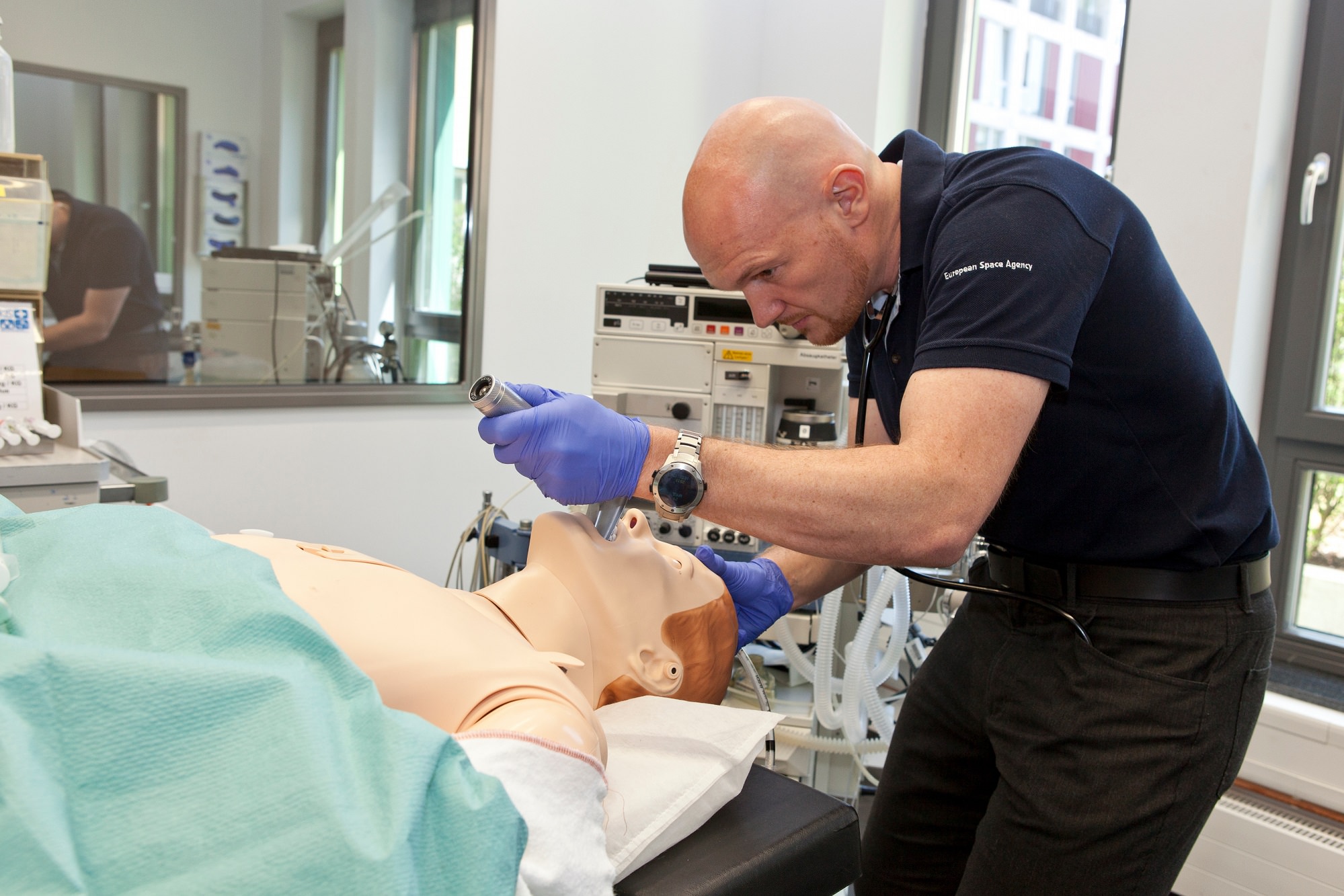
Should an astronaut get sick on the International Space Station, that could be a bad scene given the nearest hospital requires a spaceship ride. That’s why every crew has at least two medical officers on board that can deal with some routine procedures, getting to items as complex as filling teeth, for example.
How to get that training done?
Here’s an example: above is Alexander Gerst, an astronaut with the European Space Agency, recently working with a mannequin at the Uniklinik Köln, a hospital in Cologne, Germany. The mannequin is at least as realistic as some baby dolls you can buy in stores: “it blinks, breathes and responds to injections”, ESA stated.
That’s in addition to three days Gerst spent in operating theatres, emergency and the intensive care unit at the hospital. He has about another year to do medical training before going to station for Expedition 40/41 in May 2014.
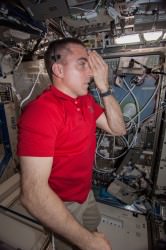
Mind you, help is also a phone call away to a ground control station, who has doctors on site. Also, there are a lot of medical doctors or similarly trained personnel that fly in space.
On board the International Space Station right now is a trained Navy SEAL, for example: Chris Cassidy. He would have been trained to treat injuries during combat. In May, he told Universe Today that he expects “muscle memory” would kick in during an emergency, whether medical or station-related:
“I think just the training that I got in the field, training in the early part of my Navy career, and during my time being an astronaut will all combine together,” he said.
“What I know from combat in the Navy, there’s a sort of calmness that comes over people who are well-trained and know what to do. Muscle memory kicks in, and it’s not until after the thing is over that you realize what you went through.”
While those who fly in space train for medical emergencies, they also serve as medical guinea pigs for ongoing experiments. Turns out microgravity simulates aging processes on Earth, so the research could have benefits on the ground in future decades. Here’s a couple of experiments happening right now on station:
- Space Headaches: “Current, pre, in-flight and post-flight data via questionnaires to evaluate the prevalence and characteristics of crewmembers’ headaches in microgravity.”
- Reaction Self Test: “A portable 5-minute reaction time task that will allow the crewmembers to monitor the daily effects of fatigue on performance while on board the International Space Station.”
Looking at the medical aspect alone, it’s abundantly clear why astronauts spend years in training before flying to the station. Remember, though, this is on top of other science experiments they do there, not to mention repairs, maintenance and the occasional spacewalk or catching a supply spacecraft.
Former Navy SEAL Survived ‘Hell Week’ En Route to Space

If a meteor hit the station, or a fire suddenly broke out, you’d want some pretty quick-thinking people on board to solve the problem. Thankfully, Chris Cassidy — a former Navy SEAL — is on his way to station in just a couple of weeks as a part of Expedition 35/36.
SEAL training is perhaps the most vigorous military program in the world. Even a quick look at the tests candidates must pass makes us feel exhausted. You need to master a suite of skills that range from demolition to navigation to, of course, fast swimming. There’s something called “combat diving”, which is supposed to test how well these Navy people “perform in stressful and often uncomfortable environments.”
And don’t forget “hell week.” Candidates only get to sleep four hours in 5.5 days. They rack up 200 miles of running through physically training for 20 hours a day. (No, those numbers are not typos. It’s real.)
Cassidy — who by the way, passed that gruelling SEAL training on the first try without getting hurt or going crazy — told Universe Today last week about what he would do should he be faced with an emergency in space.
I think just the training that I got in the field, training in the early part of my Navy career, and during my time being an astronaut will all combine together. What I know from combat in the Navy, there’s a sort of calmness that comes over people who are well-trained and know what to do. Muscle memory kicks in, and it’s not until after the thing is over that you realize what you went through.
I kind of think that’s how me as an individual, and we as a crew, will respond to any dicey dynamic event like that. Just work through the procedures that we’ve been trained, make the place safe if we can, and if we can’t, we are trained to evacuate. And the procedures all get us to that point.
Cassidy further joked that some of the humor SEALs use might not be appropriate in his most recent job title; former SEAL and International Space Station Expedition 1 commander William Shepherd once told Cassidy he might be “kicked out of a NASA meeting” if he used some of the language.
More seriously, though, Cassidy said he is particularly looking forward to doing experiments measuring bone mass on the International Space Station. Since that research has applications for people on Earth (particularly those facing osteoporosis he said it’s a demonstration of how spaceflight can help further health work on the ground.
His ultimate goal? “To be called back [to station] a second time.” Let’s hope he makes it.
Cassidy and his crewmates Pavel Vinogradov and Alexander Misurkin are scheduled to launch from the Baikonur Cosmodrome in Kazakhstan on March 29. Here a look at some of the final training the crew received at the Gagarin Cosmonaut Training Center in Star City, Russia:

